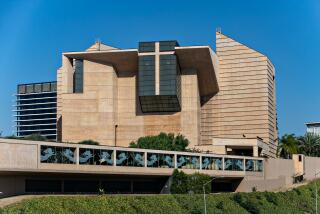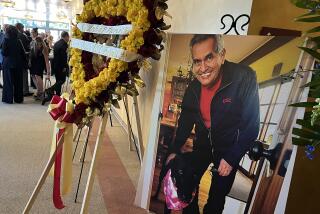Topics / RELIGION : A Window Into Life of an Activist Minister : Commemoration: Admirers of the Episcopal priest Richard Parker raise $18,000 for a stained-glass work at the Hermosa Beach church he served for 40 years.
- Share via
The Rev. Richard Parker never shied away from controversy.
During the civil rights movement of the 1950s and ‘60s, the Hermosa Beach minister preached against segregation. When he saw young Vietnam War protesters camping out on the city’s shores in the early 1970s, he founded a house where they could sleep. He spoke out against Proposition 13.
So when Parker died in 1991, parishioners and friends at St. Cross By The Sea Episcopal Church, where he ministered for 40 years, vowed he would be remembered. They pitched in $18,000 and, in January, installed a colorful 7-foot-by-7-foot stained-glass window in the church chapel with Parker’s friendly image at its center.
The window, with its deep azure blues and vibrant reds, offers a glimpse into a long, active life in Hermosa that began when a young, enthusiastic Parker was called to serve in the sparsely populated community in 1939.
“I hear tell that in the 1940s any time a strange license plate went through town, (Parker) would track down the address and call on them to attend services,” said the Rev. Paul D. Lawson, the priest at St. Cross.
*
Parker had to abandon the practice when the city’s population swelled, but his interest in the community never waned. When he retired in 1981, at the Anglican Church’s mandatory retirement age of 72, he worked on the Presiding Bishop’s Fund for World Relief until his death 10 years later.
The window’s images reflect Parker’s passions. On the left are depictions of the church, including a singing choir and an angel in prayer. On the right are scenes of the community, including images of the elderly and ill being cared for by the young and healthy.
Parker, standing stately in the window’s center, is the bridge where the two worlds meet.
“He was always out doing something,” said Margaret Parker, the priest’s 80-year-old widow, “and he always wore his collar.”
During the polio epidemic of the 1940s, Parker would fire up his blue Ford coupe and drive an hour north to help care for patients in a Los Angeles hospital. Later, he worked to establish the South Bay Hospital, and founded the 1736 House at 1736 Monterey Blvd. as a crisis center for anyone who needed help.
Through it all, the Parkers raised three boys. And the minister never lost his sense of humor, Margaret Parker said. At a time when traditional titles were changing for church ministers, Parker frequently joked, “I don’t care what you call me, as long as you call me when it’s time to eat,” she said.
It was Parker’s sense of humor that allowed him to take on hot topics in the community, Lawson said.
“The magic was that he was able to do all that he did and keep people from driving him out of town,” he said. “He loved everyone.”
More to Read
Sign up for Essential California
The most important California stories and recommendations in your inbox every morning.
You may occasionally receive promotional content from the Los Angeles Times.










